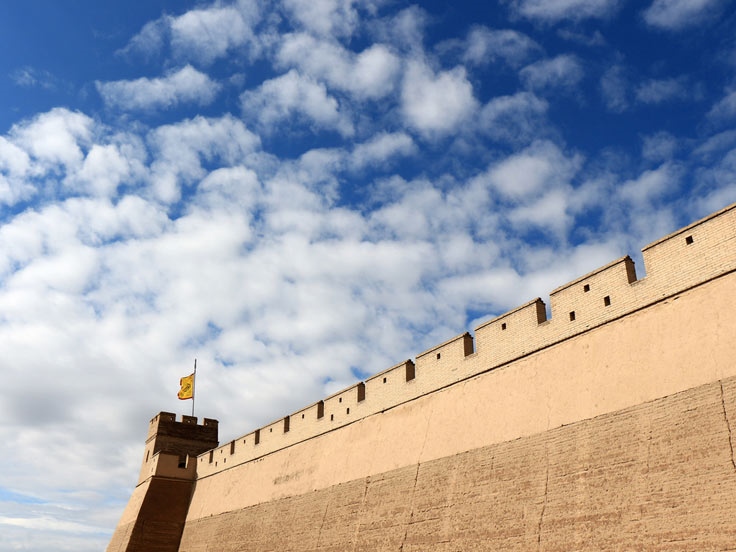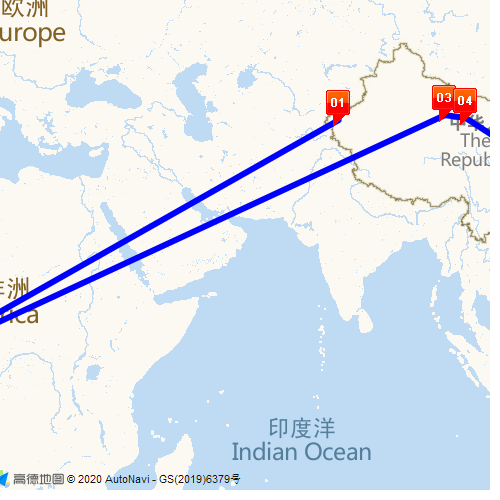Day 1: Turgart Pass - Kashgar (about 60km)
Day 2: Kashgar - Taffic Authority - Kashgar (about 90km)
Day 3 Kashgar
Today is free to explore on your own in Kashgar.
We recommend you to pay a visit to the Kashgar Bazaar, one of the largest outdoor markets in mid-Asia. Little donkeys with harmoniously tinkling bells thread their way among the throngs of people entering and leaving the bazaar. Here you can find beautiful pots and bowls engraved with delicate and intricate traditional designs, or the simple, everyday kitchenware.
The Old Town of Kashgar and the Id Kah Mosque are also on our recommendation list.
Day 4: Kashgar - Hotan (about 520 km)
Today drive from Kashgar to Hotan (driving time is approximately 6 - 7 hours). There will be two stops totaling about two hours. The main stop will be in Yarkant (also known as Shache) with lunch, an important trade center that Marco Polo visited twice.
You will arrive in Hotan in the evening. Bask in the cool breeze of twilight Hotan till dusk, and you'll find yourself so wound up.
Day 5: Hotan - Minfeng (about 290 km)
Day 6: Minfeng - Middle of Taklamakan Desert (about 400 km)
Today you'll start early at the crack of dawn as you're exploring the vast Taklamakan Desert all along the way. Bounded by the Kunlun Mountains to the south, and the Pamir Mountains and Heavenly Mountains to the west and north, the Taklamakan Desert is crossed at its northern and at its southern edge by two branches of the Silk Road as travelers sought to avoid the arid wasteland.
When night falls, we will pull into the hotel right in the middle of the Taklamakan Desert. For those who want to feel the pulse of the desert, the camping site may be your first choice.
Day 7: Middle of Taklamakan Desert - Korla (about 500 km)
Day 8 Korla - Turpan (about 400 km)
This morning we'll take a scenic drive around Korla, the second largest city in Xinjiang, known as "Oasis in the Gobi Desert".
Korla is also a city of pears, always inviting you a taste at its "King of Fruits"--juicy sweet pears.
Pause midway for a visit to the mysterious ruins of Jiaohe City (UNSECO), which reveals traces of a prosperous ancient trading center and military base 600 years ago.
Then admire the Karez System (UNESCO) nearby--an underground irrigation system which is considered to be one of the three great ancient projects of China. Its main function is to deliver water from the nearby snow-capped mountains to Turpan and its agricultural fields.
Drive across the Heavenly Mountains to Turpan, rest of the day at leisure.
Day 9: Turpan - Hami (about 420 km)
This morning you'll take a tour around Turpan.
You'll cover the Sugong Pagoda (also called Emin Minaret), an exquisite Islamic tower, the biggest pagoda in Xinjiang.
Then visit the Astana Tombs, a big graveyard of generally Chinese tombs and Chinese shrines dating from the middle in the 200s to late 700s. Ancient Gaochang people retained a common Chinese belief that life after death was like this life complete with bureaucracies and money, so the tombs contain the things people need such as food, clothing, and shoes, or representations of these commodities in the form of figurines.
Time permitted, you’ll definitely want to stop for a while at the Flaming Mountain, made famous in the Chinese classic literature of Journey to the West.
Depart Turpan for Hami for the better part of the afternoon.
Day 10: Hami - Dunhuang (about 400 km)
Hami is home to the household fruit--Chinese Hami melon. The outer color of the lemon is generally white through pink or yellow through green, while the inside flesh is sweet and crispy. Take a bite, and right away you'll feel sweetness within. Preserve Hami melons as alternatives for bottled water. Buy however much you want as you still have 400 km drive southeastwards towards Dunhuang for today.
Day 11: Dunhuang
Drive 25 km southeast of Dunhuang, and you'll begin today's tour from the Mogao Caves.
The Mogao Caves, also known as the Caves of the Thousand Buddhas is the most famous grottoes in China. The Mogao Caves are mostly famous for its massive Buddha statues and 45,000 brilliantly bright paintings of Buddha and Chinese mythological figures.
Extending some 1,600 meters, the Mogao Caves are actually on the sandstone cliff of Singing Sand Dunes. Take a safari into the sand dune. From a distance make sure to keep your ears peeled for the whistling tunes among the sand dunes. If you are feeling adventurous, take up on an optional camel ride if it sounds enticing.
Then tour the crystal-clear Crescent Moon Lake at the foot of the Singing Sand Dunes.
Day 12: Dunhuang - Jiayuguan (about 370 km)
Day 13: Jiayugaun Pass - Jiuquan - Wuwei (about 500 km)
After breakfast, you will first visit Jiayuguan Pass, the western end of the Great Wall. The legendary Jiayuguan Pass lies at the base of Jiayu Mountains, known as the most strategic fortress along the ancient Silk Road.
Drive to Jiuquan by lunch time. Then head for Wuwei. Located on the historical Silk Road, Wuwei has a very long history since there were people living here 5,000 years ago.
Day 14: Wuwei - Lanzhou - Pingliang (about 700 km)
Day 15: Pingliang - Xi'an (about 320 km)
After the breakfast in Pingliang, take a visit to Mt. Kongtong, one of the holy sites of Taoism.
Then take a tour to the Giant Buddha Grottos in Binxian, the largest Buddha grotto in Shaanxi.
After a short lunch break you'll drive to Xi'an, the ancient capital for 11 dynasties east of the Silk Road, is the capital of Shaanxi Province.
Day 16: Xi'an
Today's excursion starts with the Ancient City Wall, one of the oldest walls in China and still compasses the center of Xi'an.
Then visit the Museum of Terra Cotta Warriors and Horses (UNESCO), one of the greatest archaeological discoveries in the world. More than 6,000 life-sized terra cotta warriors, archers, infantrymen, horses and bronze chariots silently guarded the tomb of China's First Emperor for over 2,200 years.
Head to the Wild Goose Pagoda, a Tang Dynasty landmark. This seven-story pagoda was initially constructed in 652 A.D., and a larger team of scholars was organized here for translation of the Buddhist sutras brought back from India, thus the pagoda became a holy place for pilgrimages.
Take a visit to the century-old Great Mosque, which blends Islamic mosque styles and traditional Chinese archetactural elements. The Tang Dynasty Palace will also be covered if time permitted.
Day 17: Xi'an - Luoyang (about 370 km)
Depart from Xi'an to Luoyang.
Spend the rest of the day in Luoyang. Situated on the central plain of China, along with Xi'an, Luoyang was also one of the Four Great Ancient Capitals of China, and is the cradle of the Chinese civilization.
The Longmen Grottoes (UNESCO) are among the must-sees in this ancient city. Along with Mogao and Yungang, the Longmen Grottoes are one of the three most famous ancient sculptural sites in China. Carved 1,500 years ago, Longmen Grottoes are also the longest established art form which plays a significant role in the cultural evolution of Asian Buddhism.
Day 18: Luoyang - Anyang (about 300 km)
Visit the Shaolin Temple en route. Shaolin Temple is a UNESCO World Heritage Site. Built in the 5th century, the temple is world-famous for its connections with Chinese martial arts - Shaolin Kung Fu. China’s largest pagoda forest also lies in Shaolin Temple, which is a collection of more than 240 tomb pagodas for eminent abbots and monks of the temple. Drive to Anyang for a night's rest.
Day 19: Anyang - Tianjin (about 530 km)
Day 20: Tianjin - Beijing (about 150 km)
-
Driving Route:
Turgart Pass - Kashgar - Yecheng - Mazar - Daliushutan - Songxi - Bankun Tso - Rutok - Gar - Toling - Zanda - Barga - Mt. Kailash - Payang - Tingri - Zhangmu Pass
-
Important Notice
1. The administration only issues permits to the certified travel operators, not availed to any requirement by individual travelers. We'll assist you with driving, import & re-export permits and licenses at the public security bureau, traffic bureaus and the Customs for a more flexible and efficient journey.
2. Leaving the team is not allowed. Tour guide service will be provided throughout the journey.
3. The above quotations are for reference and are subject to change during some Chinese festivals, holidays, and big events. You are suggested to confirm the tour price with travel adviser in such cases.
4. Due to the road conditions, weather, and availability of hotels, the tour guide may adjust the program accordingly.
- Permits issued by China National Tourist Administration and Ministry of the Public Security, including cars / motorbikes import & re-export permit from China Customs; temporary vehicle travel & driving permits; temporary number plates
- Limited personal travel injury insurance in China
- Compulsory traffic insurance of vehicle
- One English-speaking guide accompanying the group all the trip
- Agent’ s fee of Customs declaration
- Hotel accommodations; (Our guide can help you with the hotel booking all the way according to your request and budget)
- Meals
- Sightseeing tickets
- Tips to the guide
- Road toll, parking fee and any cost related to the vehicle.





